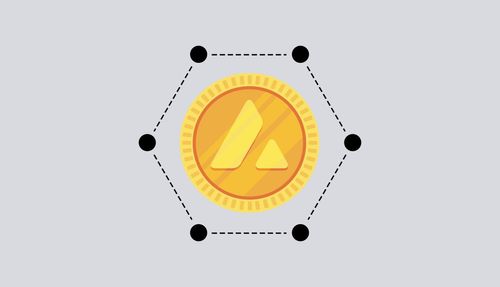What is Avalanche (AVAX)?
For Beginners

Avalanche is an eco-friendly blockchain platform that can address issues that even some of the well-known projects face through its unique Proof of Stake mechanism as well as other tools. It supports smart contracts for dApps, written in Solidity, and integrates DeFi ecosystems, including well-established projects such as Aave and Curve, to create a more functional blockchain.
Various Wall Street companies are showing interest in Avalanche and testing its potential. In particular, it is reported that experts are studying the capabilities of the blockchain when processing transactions. Numerous businesses intend to join the DeFi sector.
While some businesses are already providing clients with apps for working in DeFi protocols, analysts observe that investors are becoming more and more interested in DeFi projects. The majority of these applications are implemented on the Avalanche blockchain. Engineers confirm the increased interest in Avalanche but prefer not to go into specifics.
AVAX Token
The platform has its own token – AVAX, which is used to enable transactions within its ecosystem. It is used to pay fees to facilitate transactions on the network, take part in governance, and distribute system rewards.
More AVAX tokens are unlocked regularly. The next unlocking of AVAX tokens is just around the corner. During the event, approximately $213.35 million worth of AVAX tokens will be unlocked. These 9.54 million tokens represent 2.68% of the circulating token supply.
Unlocked tokens get distributed among strategic partners, founders, and the project team, as well as the community through airdrops. The largest share of tokens is intended for the team - 4.5 million AVAX worth $100.62 million.
Advantages Avalanche (AVAX)
Avalanche handles an impressive number of transactions per second. It is known that the Avalanche blockchain can process about 4.5 thousand transactions in just one second. In addition, this feature does not limit the system in its ability to meet increasing demand. This is also a significant factor.
The Avalanche's advantages include limited emissions, as there can be no more than 720 million tokens. In addition, being an open-source project (publicly available in March 2020), it allows anyone to view and contribute to the development of the platforms' code.
Compared to other cryptocurrencies, AVAX has a unique architecture that allows for a high level of adaptation to desired requirements and flexibility. It supports subnets, which are customizable blockchains that can be tailored to specific use cases and needs. Additionally, Avalanche has a built-in decentralized exchange called Pangolin, which allows users to trade assets without relying on a centralized exchange.
How Avalanche Works
The main network operates on three blockchains at once. Each of them is responsible for solving certain problems:
Exchange chains are made to handle transactions and let users can receive and send tokens to one another.
Staking and validator actions need the use of a platform chain.
Contract chain is designed for DeFi, smart contracts, and the implementation of decentralized apps.
Avalanche is a secure, decentralized, and trusted platform consisting of interconnected blockchains. It uses a unique set of protocols to ensure consensus among network components. Each of these blockchains may have its own Proof-of-Work or Proof-of-Stake consensus model.
Each blockchain is verified by a single subnet, which can verify more than just one blockchain. In a comparable manner, a validator node may belong to many subnets. One important feature is the ability to design subnets that maintain specific attributes. With Avalanche, anyone can easily build a blockchain that works exactly the way they need it. To create such blockchains, one can even use well-known programming languages such as Go.
Future of Avalanche
AVAX has incredibly bright future possibilities, particularly in the long run. Here are a few reasons why:
Compared to Ethereum, it is far more fun to use. Thus, a sizable portion of the assets shift from one network to another when consumers of decentralized apps have an Ethereum substitute in the form of Avalanche. The Avalanche ecosystem benefits from this, and the value of the coin rises.
When AVAX's burning functionality was first released in 2021, the blockchain developers declared that all commissions from AVAX transactions would be burnt. Due to this, the number of tokens in circulation has begun to decrease, which will raise the price.
Conclusion
This platform is not some kind of record holder in the field of transaction processing speed, capitalization, or popularity. However, due to a combination of factors, Avalanche (AVAX) is an interesting option for investment, which is confirmed by the fact that a number of large companies are cooperating with it.
With a focus on DeFi and a multifaceted strategy of customizability, scalability, and interoperability, Avalanche hopes to differentiate itself from multiple worthy and unworthy projects appearing on the market. Although it is too early to tell if the platform will eventually threaten Ethereum's market share, Avalanche is well on its way to creating its own ecosystem and has demonstrated a particular knack for DeFi applications.
AVAX on CoinDepo
The CoinDepo platform supports Avalanche (AVAX) as one of the main cryptocurrencies. With CoinDepo, you can safely store your AVAX in Compound Interest Accounts and earn from 12% to 18% per annum + compound interest, depending on the type of interest account you choose. Today, without exaggeration, this is the best offer on the market.
You can also borrow other major cryptocurrencies and stablecoins from CoinDepo against your AVAX portfolio without opening a collateral account, which is a unique service that has no analogs in the world of digital assets.


